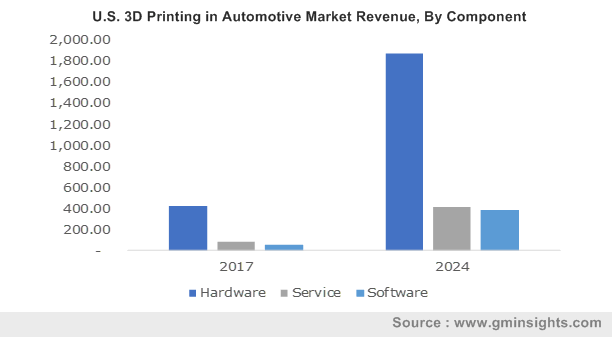3D printing market in automotive sector to be delineated by the changing demands of design and manufacturing, Europe to emerge as a prominent investment hub over 2018-2024
Publisher : Fractovia | Published Date : 2018-09-12Request Sample
Owing to the surging transformation in automotive design with regards to creativity, innovation, and environmental concerns, 3D printing market in automotive sector has experienced a proliferating growth path in recent times. Earlier, 3D printing had not been adopted globally, however, with the increasing environmental and economic concerns, most of the automakers have now adopted this technology for designing and manufacturing various automotive components.
U.S. 3D Printing in Automotive Market Revenue, By Component

As of now, some of the leading contributors in the automotive industry comprising Daimler, VW, Porsche, Audi, Rolls-Royce, and many other e-vehicle manufacturers use 3D printing technology for manufacturing complex automotive parts. The acceptance of this emerging technology by various leading automakers is poised to impel 3D printing industry in automotive sector trends. Currently, the automakers are focusing on reducing the lead time required to develop new vehicle models that will help them to not only gain competitive benefits but will also help reduce the cost associated with the product development stages.
Enumerated below are some instances validating the increasing adoption of 3D printing technologies by various automakers that have been influencing 3D printing industry in automotive sector.
Daimler to set up a new 3D printing technology facility to produce parts for the aerospace and automotive industries
The leading German automaker, Daimler has collaborated with a 3D printing specialists EOS, and Premium Aerotec for a 3D printing technology project dubbed as NextGenAM. In this set-up, the company plans to manufacture various metal and carbon fiber automotive components and aircraft structures. The firm plans to deploy various automated machines at the plant that could be used for additive manufacturing, post-processing, and quality assurance. The implementation of such digitized 3D printing facilities could help automakers enhance the manufacturing capability while reducing production cost per component.
The development of 3D printed electric vehicles to enhance share of 3D printing market in automotive sector
Over the last few years, with the increasing awareness about the energy efficiency, the popularity of e-vehicles has increased tremendously. In line with the surging adoption of e-vehicles and the supportive regulatory norms, many automakers are investing in electric vehicles. In this regard, for achieving competitive benefits, some EV manufacturers have adopted new technology trends such as 3D printing and additive manufacturing. As on today, numerous 3D printed cars have actually been developed, however, not all of them are practically used. In order to change the perspective of consumers, the Italian car manufacturer, XEV has started the production of 3D printed vehicles dubbed as LSEV which will be available in the market by the next year.
Speaking along the same line, the Italian car manufacturer will start manufacturing its 3D printed cars at its China-based mega factory. XEV is developing nearly 2,000 plastic extrusion 3D printers in which it can use Wrap-Free technology that will hide all the surface layers generated due to fused deposition modeling (FDM). The use of 3D printing technology for the mass production of this customizable car will help XEV to enhance its customer base across the globe over the years ahead.
The on-going partnerships among 3D printing technology providers and automakers to stimulate 3D printing market in automotive sector
In 2017, renowned automotive manufacturer, Audi signed on a strategic partnership with one of the leading 3D printer manufacturers known for its industrial-sized direct metal laser sintering machines, EOS. This technology partnership will help Audi to overcome the drawbacks associated with the conventional manufacturing technology and expand its auto-parts production capability over the years ahead.
In another instance, the German automaker, BMW has collaborated with American research institute, MIT for developing 3D printed inflatable materials that could be used in its futuristic vehicle interior concepts. The researchers in MIT have been continuously working on material technology to print 3D inflatable objects that could prove to be useful for BMW to develop transformative vehicle parts. The involvement of research institutes and leading automakers in the development of advanced materials for 3D printing applications is slated to propel size of 3D printing market in automotive sector.
Currently, the growing adoption of 3D printing technology for functional prototyping, mass production, design validation, and ergonomics across the automotive sector will propel the industry trends over the years ahead. The increasing importance for accuracy, reliability, and consistency in the automotive sector while developing complex designs will also improve the use of 3D printing technology. Aided by the ongoing product innovations across the automotive sector, 3D printing market in automotive sector will surpass a revenue collection of USD 8 billion by the end of 2024.